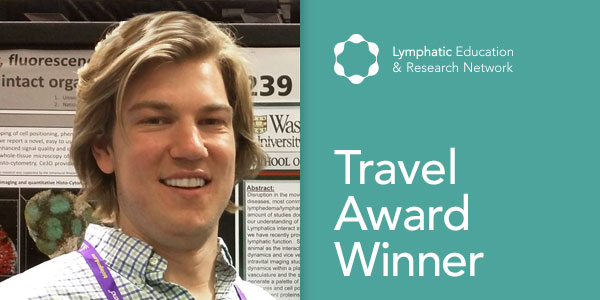Brian Saunders, currently a post-baccalaureate student in the department of Pathology & Immunology at Washington University in St. Louis, under the supervision of Bernd Zinselmeyer PhD received support from LE&RN to present at the American Association of Immunologists Annual Meeting on May 16, 2016, in Seattle, Washington. It was a groundbreaking achievement to have lymphatics address in the Technical Innovations section of the Conference. We asked Brian to share his thoughts on that experience with us and to tell us a bit more about his research and future plans.
1. What did you get out of the Conference? Why did you feel it was important to attend?
This was my first time attending AAI and it was amazing to witness so many people in one location all focused on immunology. Being able to share my work both as a poster and as a presenter at the conference was an incredible opportunity for me to share some of the work I have been doing. This also gave me the chance to get some feedback from people within the field along with interacting with those who could see some of the work we were doing and applying it to other areas. The coolest part about this was seeing other people finding my work interesting, getting validation outside of my lab is a very reassuring feeling. This reinforces the direction that my work is going in and also acts as a driving force to keep working at what I am doing.
2. What are your areas of interest in research?
We focus on visualization of the phenotypes of lymphatic function and dysfunction within the native tissue of live mice. My main body of work is associated with a sophisticated system called a Two-photon Microscope. This system uses a high wavelength pulsed laser giving us the ability to image fluorescently labeled markers, such as cells, dyes or microspheres, within live mouse models. Using this system we have measured myeloid cell dynamics surrounding the lymphatics and attempted to better understand they interact with the lymphatics.
3. What are your hopes and plans for your career and your research?
Next year I am hoping to begin my path to becoming an M.D. This will give me an education where I can bridge the gap between the clinical and research side of work. My goal until then is to continue working on improving the imaging techniques that we use to be able to better view the lymphatics in the live models. I have begun work to better be able to understand lymphatic flow dynamics and cells regulating these properties. I’m currently working on a way to automate these measurements within specific areas of the mouse using programs like MATLAB.
4. Why do you believe that, in general, lymphatic research is important? What might the field accomplish within the next few years?
Until recently the field was relatively understudied, and even now there is a lot that we do not know, for every question that is answered more new questions arise. Lymphatic research is important because these vessels allow the leukocytes to provide a rapid dynamic response to specific areas throughout the body. When this is malfunctioning the immune system as a whole cannot work with full efficiency and can contribute to local inflammatory disease. This is why it so important to me, to understand all of the important contributors, and then, to one day be able to manipulate the genome or specific tissue to replicate a certain disease. Hopefully within a few years we will be able to recognize more genetic targets and effector cells that play an important role in orchestrating lymphatic function.
LE&RN's programs, like Travel Awards for researchers, are only possible through the commitment of LE&RN's Supporting Members. Become a Supporting Member today.

